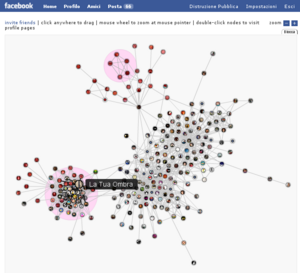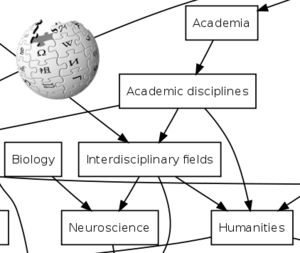Social Software and Semantic Web
Click here for a brief description of the Research Area, taken from the AirLab website.
Projects
You can also find our currently active projects here and the archive of our past projects here
Social Network Analysis
- Facebook Automatic List Suggestion (Facebook Personal Network Analysis)
- Friendship Recommendation System based on a Social Network Topological Analysis (Friendship Recommendation System based on a Social Network Topological Analysis)
- Mining the Network of Coordination Interactions in Wikipedia (Mining the Network of Coordination Interactions in Wikipedia)
- Wikipedia Social Network (Techniques to analyze the Wikipedia Social Network)
Semantic Tagging
- Tagonto (Tagonto)
- Using WordNet to support navigation in a folksonomy (Using WordNet to support navigation in a folksonomy)
- Wikipedia Category Graph (Automatically assigning Wikipedia articles to macrocategories)
- Wikipedia Category Map (Wikipedia Category Map)
- FolksOnt (A graphical tool for folksonomy-based ontology grounding" or, shortly, FolksOnt)
- Emergent Semantics in Wikipedia (Emergent Semantics in Wikipedia)
- Wikipedia Folksonomy (Studying Wikipedia as a Folksonomy)
Semantic Search
- SeQuEx (SeQuEx - Semantic Query Expansion)
Semantic Wikis
- GeoOntology (Geographic Ontology for a semantic wiki)
- BinaryTags (Binary tag system for the creation of relations in a semantic wiki)
- SeManTik (Semantic management of attachments inside a wiki engine)
- SandboxIkeWiki (A sandbox ontology system for the semantic wiki IkeWiki)
- Design and development of a semantic wiki engine (Design and development of a semantic wiki engine)
- Semantic wiki extensions with context ontologies (Semantic wiki extensions with context ontologies)
- Extending a wiki with semantic templates (Extending a wiki with semantic templates)
Semantic Annotations
- A tool to find and store annotations into a unifying semantic ontology (A tool to find and store annotations into a unifying semantic ontology)
- Firefox Extension for Semantic Annotation (Firefox Extension for Semantic Annotation)
- SpeakinAbout (Speakin' About - a tool for semantic annotation of text documents)
- A Unifying Framework for Semantic Annotation (A Unifying Framework for Semantic Annotation)
Semantic Filesystems
Description Logics
- OWLIE (A Web application for collaborative editing of ontologies)
- Description Logics Extensions (A fuzzy description logics temporal extension)
Project Proposals
Social Network Analysis:
| Wiki Page: Facebook automatic list suggestion Title: Facebook Automatic List Suggestion |
| Wiki Page: Social Network Data Extraction from Online Communities Title: Social Network Data Extraction From Online Communities |
| Wiki Page: Wikipedia Page Social Network Title: Wikipedia Page Social Network |
| Wiki Page: Wikipedia Tripartite Graph Title: Wikipedia Tripartite Graph |
Semantic Tagging:
| Wiki Page: Mining wikipedia categories Title: Wikipedia category map |
| Wiki Page: Wikipedia Tripartite Graph Title: Wikipedia Tripartite Graph |
Semantic Search:
| Wiki Page: Extending a search engine with semantic information Title: Extending a search engine with semantic information Aim of this project is to expand a traditional search engine with semantic information, so that also documents containing words related to the ones in the query can be retrieved. Existing thesauri and ontologies can be used, as well as more dynamic and collaborative sources of knowledge such as user tags and wikipedia pages and categories. Starting points for this work can be the projects "SeQuEx - Semantic Query Expansion" and "Enriching search results with semantic metadata". |
Semantic Annotations:
| Wiki Page: A firefox extension for semantic annotations Title: A Firefox extension for semantic annotations |
| Wiki Page: Annotation aggregators from social applications Title: Annotation aggregators from social applications |
| Wiki Page: Detecting patterns in ontology usage Title: Detecting patterns in ontology usage |
| Wiki Page: Use case design and implementation for semantic annotations Title: Use case design and implementation for semantic annotation One possible example is the annotation of mp3 files available on the Web. They can be classified in genres or associated to datatype properties, such as rating, title, length and release date... also exploiting data already available in http://musicbrainz.org/ |
People
- DavidLaniado (PhD)
- DavideEynard (Researcher)
- FabioMarfia (PhD)
- MarcoColombetti (Prof)
- RiccardoTasso (Researcher)
Useful Resources
- Semantic Web Links, a collection of links for those who want to work with Semantic Web technologies and wikis
- Semantic MediaWiki installation, a guide to install a local version of MediaWiki and its semantic extension
- Persistent Ontologies, a collection of links to material about making ontologies persistent
- Writing a Firefox extension, some hints and pointers to tutorials that will help you create an extension for Firefox
- Bibliography, a huge collection of papers on semantics, wikis and folksonomies on bibsonomy
List of relevant publications
2008
- Davide Eynard and Marco Colombetti. Exploiting User Gratification for Collaborative Semantic Annotation. Semantic Web User Interaction at CHI 2008: Exploring HCI Challenges.
- Silvia Bindelli, Claudio Criscione, Carlo Curino, Mauro L. Drago, Davide Eynard, and Giorgio Orsi. Improving search and navigation by combining ontologies and social tags. In OTM Workshops, volume 5333 of Lecture Notes in Computer Science, pages 76-85. Springer, 2008.
2007
- David Laniado and Davide Eynard and Marco Colombetti. Using WordNet to turn a folksonomy into a hierarchy of concepts. Semantic Web Application and Perspectives - Fourth Italian Semantic Web Workshop, 192–201, 2007.
- David Laniado and Davide Eynard and Marco Colombetti. A semantic tool to support navigation in a folksonomy. HT ‘07: Proceedings of the 18th conference on Hypertext and hypermedia, 153–154, ACM Press,New York, NY, USA,2007.



